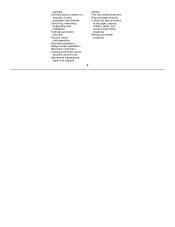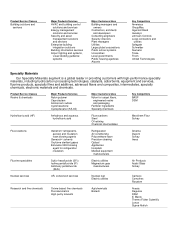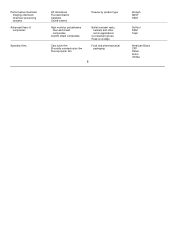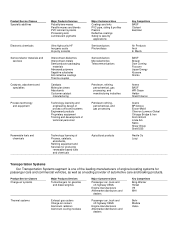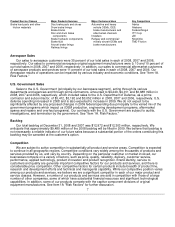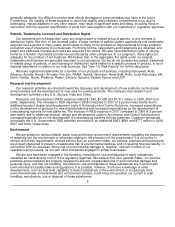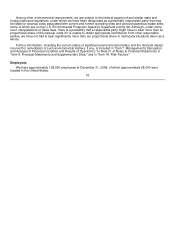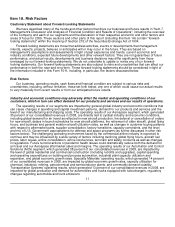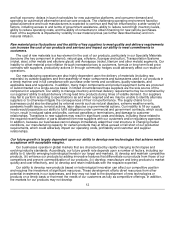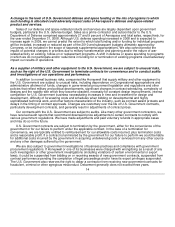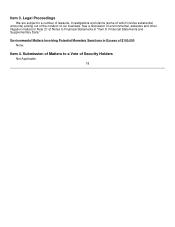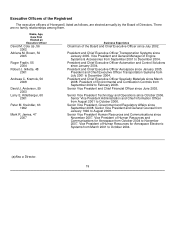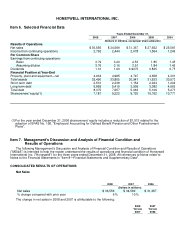Honeywell 2008 Annual Report Download - page 21
Download and view the complete annual report
Please find page 21 of the 2008 Honeywell annual report below. You can navigate through the pages in the report by either clicking on the pages listed below, or by using the keyword search tool below to find specific information within the annual report.
and fuel economy, delays in launch schedules for new automotive platforms, and consumer demand and
spending for automotive aftermarket and car care products. The challenging operating environment faced by
global automotive and truck manufacturers is expected to continue and may be influenced by a wide variety of
factors, including access to and terms of government assistance, ability to reduce record high inventory levels,
ability to reduce operating costs, and the ability of consumers to obtain financing for new vehicle purchases.
Each of the segments is impacted by volatility in raw material prices (as further described below) and non-
material inflation.
Raw material price fluctuations and the ability of key suppliers to meet quality and delivery requirements
can increase the cost of our products and services and impact our ability to meet commitments to
customers.
The cost of raw materials is a key element in the cost of our products, particularly in our Specialty Materials
(benzene (the key component in phenol), natural gas, ethylene, fluorspar and sulfur), Transportation Systems
(nickel, steel, other metals and ethylene glycol) and Aerospace (nickel, titanium and other metals) segments. Our
inability to offset material price inflation through increased prices to customers, formula or long-term fixed price
contracts with suppliers, productivity actions or through commodity hedges could adversely affect our results of
operations.
Our manufacturing operations are also highly dependent upon the delivery of materials (including raw
materials) by outside suppliers and their assembly of major components and subsystems used in our products in
a timely manner and in full compliance with purchase order terms and conditions, quality standards, and
applicable laws and regulations. In addition, many major components and product equipment items are procured
or subcontracted on a single-source basis; in limited circumstances these suppliers are the sole source of the
component or equipment. Our ability to manage inventory and meet delivery requirements may be constrained by
our suppliers' ability to adjust delivery of long-lead time products during times of volatile demand. Our suppliers
may fail to perform according to specifications as and when required and we may be unable to identify alternate
suppliers or to otherwise mitigate the consequences of their non-performance. The supply chains for our
businesses could also be disrupted by external events such as natural disasters, extreme weather events,
pandemic health issues, terrorist actions, labor disputes or governmental actions. Our inability to fill our supply
needs would jeopardize our ability to fulfill obligations under commercial and government contracts, which could,
in turn, result in reduced sales and profits, contract penalties or terminations, and damage to customer
relationships. Transitions to new suppliers may result in significant costs and delays, including those related to
the required recertification of parts obtained from new suppliers with our customers and/or regulatory agencies.
In addition, because our businesses cannot always immediately adapt their cost structure to changing market
conditions, our manufacturing capacity for certain products may at times exceed or fall short of our production
requirements, which could adversely impact our operating costs, profitability and customer and supplier
relationships.
Our future growth is largely dependent upon our ability to develop new technologies that achieve market
acceptance with acceptable margins.
Our businesses operate in global markets that are characterized by rapidly changing technologies and
evolving industry standards. Accordingly, our future growth rate depends upon a number of factors, including our
ability to (i) identify emerging technological trends in our target end-markets, (ii) develop and maintain competitive
products, (iii) enhance our products by adding innovative features that differentiate our products from those of our
competitors and prevent commoditization of our products, (iv) develop, manufacture and bring products to market
quickly and cost-effectively, and (v) develop and retain individuals with the requisite expertise.
Our ability to develop new products based on technological innovation can affect our competitive position
and requires the investment of significant resources. These development efforts divert resources from other
potential investments in our businesses, and they may not lead to the development of new technologies or
products on a timely basis or that meet the needs of our customers as fully as competitive offerings. In addition,
the markets for our products may not develop
12


